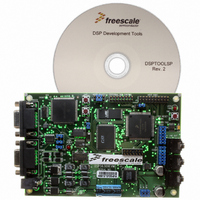DSP56309EVM Freescale Semiconductor, DSP56309EVM Datasheet - Page 3

DSP56309EVM
Manufacturer Part Number
DSP56309EVM
Description
KIT EVALUATION FOR XC56309
Manufacturer
Freescale Semiconductor
Type
DSPr
Specifications of DSP56309EVM
Contents
Module Board, Installation Guide, Power Supply, Cable, Software and more
Description/function
Audio DSPs
Product
Audio Modules
For Use With/related Products
DSP56309
Lead Free Status / RoHS Status
Contains lead / RoHS non-compliant
2
This application note describes how to use the new Symphony Studio Development Software with the
DSP563xxEVM. Symphony Studio uses the extensible development platform Eclipse, which is an open
source industry standard, to provide a new way to develop code through an Integrated Development
Environment (IDE). The IDE allows code creation and editing as well as project management, debugging
and code compilation all in one software suite. Symphony Studio is fully backward compatible with
existing application code, as the Suite56 assembler and linker tools are reused in the platform. Since the
toolset reuses many components from the Suite56 platform, the learning curve is minimized. The IDE
allows quicker code generation and easy program management. In addition, unlike the Suite56 tool that
only allows access to the EVM through a parallel port, the Symphony Studio allows communication to the
EVM through a USB port.
Symphony Studio can be downloaded from the Freescale web site at
http://www.freescale.com/symphonystudio. The Symphony Studio User Guide (DSPSTUDIOUG)
describes the Symphony Studio in detail. This application note assumes that the Symphony Studio has
been installed as described in Section 2 of the Symphony Studio User’s Guide.
This application note discussed two options for the hardware command converter:
3
For details, please see the Symphony Studio documentation that contains information on how to create,
build, debug and run assembly projects. There are usually multiple methods to complete any task in the
Symphony Studio, for example using a pull down menu, using a right mouse click shortcut, using a button
in the tool bar, or using one of the function keys. This document attempts to point out as many of these
techniques as possible.
Creating and editing code (including the Flash memory programming assembly code) is done in the
C/C++ perspective of Symphony Studio. Different perspectives are chosen by clicking on the
corresponding text in the tab in the top right hand corner of the Symphony Studio (C/C++ or Debug)
application window. If you do not see the perspective you need in the top right hand corner, you can use
the Window > Open Perspective > Other... pull down menu to open either of these perspectives.
Freescale Semiconductor
•
•
Symphony Studio Overview
Axiom parallel port DSP JTAG Pod (which is included with the DSP563xxEVM) for which you
must install the parallel port driver as described in Section 2.3.2 of the Symphony Studio User
Guide
Xverve USB Signalyzer Tool (with the DSP563xx adapter) for which you must install the drivers
that can be downloaded from the Signalyzer web site at http://www.signalyzer.com/. Pricing
information and a detailed description of the Signalyzer tool can also be found at the Signalyzer
web site.
Load and Edit Code: C/C++ Perspective
Using Symphony™ Studio with the DSP563xxEVM, Rev. 0
Symphony Studio Overview
3










